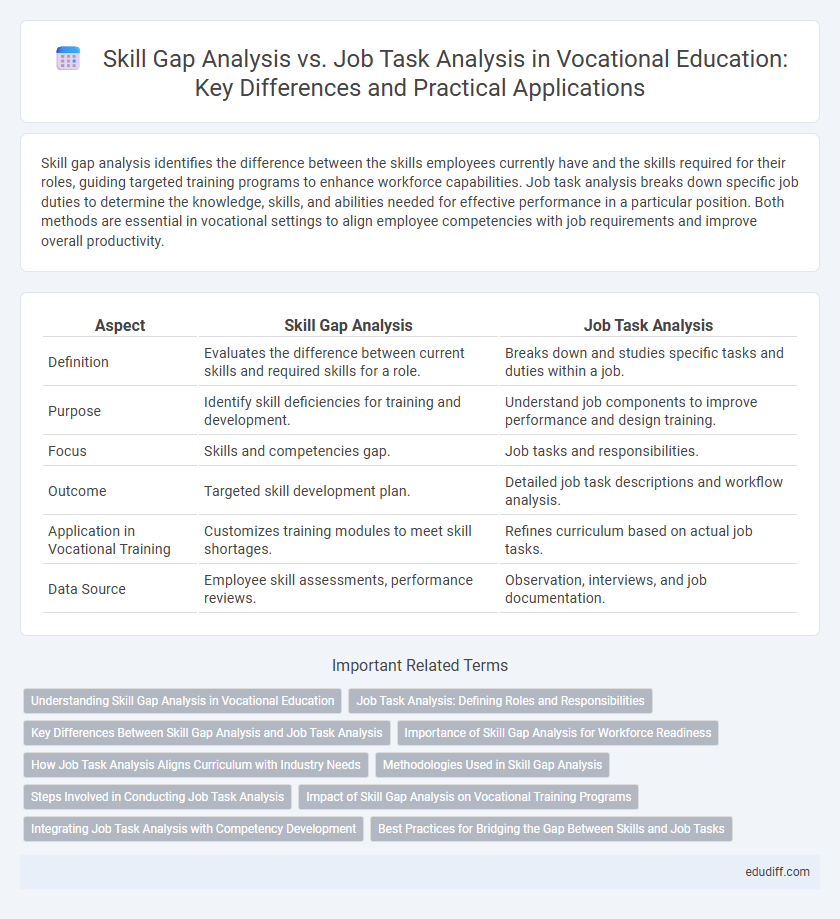Skill gap analysis identifies the difference between the skills employees currently have and the skills required for their roles, guiding targeted training programs to enhance workforce capabilities. Job task analysis breaks down specific job duties to determine the knowledge, skills, and abilities needed for effective performance in a particular position. Both methods are essential in vocational settings to align employee competencies with job requirements and improve overall productivity.
Table of Comparison
| Aspect | Skill Gap Analysis | Job Task Analysis |
|---|---|---|
| Definition | Evaluates the difference between current skills and required skills for a role. | Breaks down and studies specific tasks and duties within a job. |
| Purpose | Identify skill deficiencies for training and development. | Understand job components to improve performance and design training. |
| Focus | Skills and competencies gap. | Job tasks and responsibilities. |
| Outcome | Targeted skill development plan. | Detailed job task descriptions and workflow analysis. |
| Application in Vocational Training | Customizes training modules to meet skill shortages. | Refines curriculum based on actual job tasks. |
| Data Source | Employee skill assessments, performance reviews. | Observation, interviews, and job documentation. |
Understanding Skill Gap Analysis in Vocational Education
Skill gap analysis in vocational education identifies the difference between the skills students currently possess and those required in the workforce, helping educators tailor training programs to industry demands. It focuses on assessing competencies, knowledge, and abilities critical for specific job roles, ensuring learners acquire relevant skills for employment. This process supports aligning vocational curriculum with evolving labor market needs, enhancing student employability and addressing workforce shortages.
Job Task Analysis: Defining Roles and Responsibilities
Job Task Analysis involves systematically identifying and defining specific roles and responsibilities within a vocational setting to ensure alignment with organizational goals. This method breaks down job duties into measurable tasks, enhancing workforce competency evaluation and targeted training development. Precise role definition through job task analysis supports optimized resource allocation and performance management in skill-driven environments.
Key Differences Between Skill Gap Analysis and Job Task Analysis
Skill gap analysis identifies gaps between current employee abilities and required skills for optimal job performance, emphasizing learning needs and training priorities. Job task analysis breaks down specific duties, responsibilities, and workflows associated with a job role to create detailed task inventories and performance standards. The key difference lies in skill gap analysis targeting individual competency deficiencies, while job task analysis focuses on comprehensive task identification and job requirements.
Importance of Skill Gap Analysis for Workforce Readiness
Skill gap analysis identifies the specific competencies employees lack compared to job requirements, enabling targeted training programs that enhance workforce readiness. Job task analysis focuses on breaking down tasks and responsibilities, but skill gap analysis directly addresses the alignment between current skills and future job demands. Prioritizing skill gap analysis improves employee performance, reduces turnover, and supports strategic workforce development in vocational settings.
How Job Task Analysis Aligns Curriculum with Industry Needs
Job Task Analysis identifies specific duties and skills required by employers, providing precise data to shape curriculum development in vocational education. This alignment ensures training programs address real-world competencies, reducing skill gaps and enhancing graduate employability. By basing curriculum design on actual job tasks, institutions create targeted learning outcomes that meet current industry standards and workforce demands.
Methodologies Used in Skill Gap Analysis
Skill gap analysis employs methodologies such as surveys, interviews, assessments, and performance data analysis to identify discrepancies between existing employee skills and job requirements. It leverages competency mapping and benchmarking against industry standards to pinpoint areas needing training or development. These methods enable organizations to tailor workforce development initiatives effectively and enhance overall productivity.
Steps Involved in Conducting Job Task Analysis
Job task analysis involves systematically identifying and breaking down the specific duties, skills, and knowledge required for a particular job role, ensuring alignment with vocational training outcomes. The steps in conducting job task analysis include collecting job data through observations and interviews, categorizing tasks based on relevance and frequency, and validating findings with subject matter experts to ensure accuracy. This process aids in developing targeted training programs that bridge identified skill gaps effectively.
Impact of Skill Gap Analysis on Vocational Training Programs
Skill gap analysis identifies discrepancies between the skills possessed by learners and those required by specific job roles, enabling vocational training programs to tailor curricula effectively. By aligning training objectives with industry demands, skill gap analysis enhances employability and reduces workforce shortages. This targeted approach improves resource allocation and addresses evolving market needs more precisely than traditional job task analysis.
Integrating Job Task Analysis with Competency Development
Integrating Job Task Analysis (JTA) with Competency Development enhances the precision of vocational training by identifying specific tasks and skills required for job performance. Skill gap analysis complements this process by pinpointing discrepancies between current competencies and job demands, facilitating targeted upskilling strategies. This integration ensures curriculum alignment with industry standards, optimizing workforce readiness and productivity.
Best Practices for Bridging the Gap Between Skills and Job Tasks
Skill gap analysis identifies the difference between the current skills of employees and the skills required for specific job tasks, enabling targeted training programs to address deficiencies. Job task analysis breaks down each role into core responsibilities and required competencies, providing a detailed framework for aligning workforce development with actual job demands. Best practices for bridging the gap include continuous feedback loops, competency-based training modules, and integrating real-time performance data to ensure skills acquisition matches evolving job task requirements.
Skill gap analysis vs Job task analysis Infographic

 edudiff.com
edudiff.com